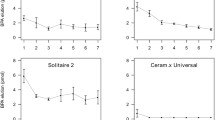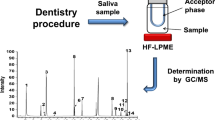Abstract
Objectives
The aims of this study were to quantify salivary concentrations of bisphenol A (BPA) and to assess if presence of dental composite fillings is associated with higher BPA levels in saliva.
Materials and methods
Twenty individuals with six or more tooth surfaces filled with polymer-based dental materials (composite group) and 20 individuals without any polymer-based materials (control group) were included in the study. Saliva was collected in polypropylene tubes and stored at −80 °C before analysis. Concentration of free (unconjugated) and total bisphenol A was determined by liquid chromatography/mass spectrometry (LC/MS). Values below limit of detection (0.1 ng/mL) were set to one-half of the limit of detection. Mann-Whitney U test (one sided; the Exact Tests Option in IBM-SPSS version 21) was used for the statistical analyses.
Results
The concentration of BPA in saliva was very low. In the composite group, 8 of 20 samples had detectable concentrations of BPA. In the control group, 3 of 20 samples had detectable concentrations of BPA. Statistical analysis indicated that the concentration of unconjugated BPA was slightly higher in the composite group (p = 0.044) than in the control group.
Conclusions
Presence of dental composites may be associated with slightly higher concentration of unconjugated BPA in saliva. However, additional studies using sensitive analytical methods are needed before firm conclusions can be drawn. Influence from other factors, like food intake and time of the day for saliva sampling, must be considered.
Clinical relevance
The relative contribution of existing polymer-based dental fillings to total BPA exposure seems to be low.

Similar content being viewed by others
References
Crain DA, Eriksen M, Iguchi T, Jobling S, Laufer H, LeBlanc GA, Guillette LJ Jr (2007) An ecological assessment of bisphenol-a: evidence from comparative biology. Reprod Toxicol 24:225–239. doi:10.1016/j.reprotox.2007.05.008
SCENIHR (2015) Opinion on the safety of the use of bisphenol A in medical devices. Scientific Committee on Emerging and Newly Identified Health Risks. http://ec.europa.eu/health/scientific_committees/emerging/opinions/index_en.htm. Accessed 18 February 2015
Ashby J, Odum J, Paton D, Lefevre PA, Beresford N, Sumpter JP (2000) Re-evaluation of the first synthetic estrogen, 1-keto-1,2,3, 4-tetrahydrophenanthrene, and bisphenol a, using both the ovariectomised rat model used in 1933 and additional assays. Toxicol Lett 115:231–238
Rochester JR (2013) Bisphenol a and human health: a review of the literature. Reprod Toxicol 42:132–155. doi:10.1016/j.reprotox.2013.08.008
Welshons WV, Nagel SC, vom Saal FS (2006) Large effects from small exposures. III. Endocrine mechanisms mediating effects of bisphenol a at levels of human exposure. Endocrinology 147:S56–S69. doi:10.1210/en.2005-1159
Beronius A, Ruden C, Hakansson H, Hanberg A (2010) Risk to all or none? A comparative analysis of controversies in the health risk assessment of bisphenol a. Reprod Toxicol 29:132–146. doi:10.1016/j.reprotox.2009.11.007
Beronius A, Hanberg A, Zilliacus J, Ruden C (2014) Bridging the gap between academic research and regulatory health risk assessment of endocrine disrupting chemicals. Curr Opin Pharmacol 19:99–104. doi:10.1016/j.coph.2014.08.005
EFSA (2015) Scientific opinion on the risks to public health related to the presence of bisphenol a (BPA) in foodstuffs. EFSA J 13. doi:10.2903/j.efsa.2015.3978
Wilson NK, Chuang JC, Morgan MK, Lordo RA, Sheldon LS (2007) An observational study of the potential exposures of preschool children to pentachlorophenol, bisphenol-a, and nonylphenol at home and daycare. Environ Res 103:9–20. doi:10.1016/j.envres.2006.04.006
Vandenberg LN, Hunt PA, Myers JP, Vom Saal FS (2013) Human exposures to bisphenol a: mismatches between data and assumptions. Rev Environ Health 28:37–58. doi:10.1515/reveh-2012-0034
Stahlhut RW, Welshons WV, Swan SH (2009) Bisphenol a data in NHANES suggest longer than expected half-life, substantial nonfood exposure, or both. Environ Health Perspect 117:784–789. doi:10.1289/ehp.0800376
Hormann AM, Vom Saal FS, Nagel SC, Stahlhut RW, Moyer CL, Ellersieck MR, Welshons WV, Toutain PL, Taylor JA (2014) Holding thermal receipt paper and eating food after using hand sanitizer results in high serum bioactive and urine total levels of bisphenol a (BPA). PLoS One 9:e110509. doi:10.1371/journal.pone.0110509
Gayrard V, Lacroix MZ, Collet SH, Viguie C, Bousquet-Melou A, Toutain PL, Picard-Hagen N (2013) High bioavailability of bisphenol a from sublingual exposure. Environ Health Perspect 121:951–956. doi:10.1289/ehp.1206339
Schmalz G, Preiss A, Arenholt-Bindslev D (1999) Bisphenol-a content of resin monomers and related degradation products. Clin Oral Investig 3:114–119
Olea N, Pulgar R, Perez P, Olea-Serrano F, Rivas A, Novillo-Fertrell A, Pedraza V, Soto AM, Sonnenschein C (1996) Estrogenicity of resin-based composites and sealants used in dentistry. Environ Health Perspect 104:298–305
Van Landuyt KL, Nawrot T, Geebelen B, De Munck J, Snauwaert J, Yoshihara K, Scheers H, Godderis L, Hoet P, Van Meerbeek B (2011) How much do resin-based dental materials release? A meta-analytical approach. Dent Mater 27:723–747. doi:10.1016/j.dental.2011.05.001
American Dental Association Council on Scientific Affairs (2014) Determination of bisphenol a released from resin-based composite dental restoratives. J Am Dent Assoc 145:763–765. doi:10.14219/jada.2014.42
Kingman A, Hyman J, Masten SA, Jayaram B, Smith C, Eichmiller F, Arnold MC, Wong PA, Schaeffer JM, Solanki S, Dunn WJ (2012) Bisphenol a and other compounds in human saliva and urine associated with the placement of composite restorations. J Am Dent Assoc 143:1292–1302
Olstad ML, Holland RI, Wandel N, Pettersen AH (1987) Correlation between amalgam restorations and mercury concentrations in urine. J Dent Res 66:1179–1182
Zhang D, Fan C, Zhang J, Zhang CH (2009) Nonparametric methods for measurements below detection limit. Stat Med 28:700–715. doi:10.1002/sim.3488
Hornung R, Reed L (1990) Estimation of average concentration in the presence of nondetectable values. Appl Occup Hyg 5:46–51
Fung EYK, Ewoldsen NO, Germain HA S, Marx DB, Miaw C-L, Siew C, Chou H-N, Gruninger SE, Meyer DM (2000) Pharmacokinetics of bisphenol a released from a dental sealant. J Am Dent Assoc 131:51–58. doi:10.14219/jada.archive.2000.0019
Volkel W, Colnot T, Csanady GA, Filser JG, Dekant W (2002) Metabolism and kinetics of bisphenol a in humans at low doses following oral administration. Chem Res Toxicol 15:1281–1287
Han DH, Kim MJ, Jun EJ, Kim JB (2012) Salivary bisphenol-a levels due to dental sealant/resin: a case-control study in Korean children. J Korean Med Sci 27:1098–1104. doi:10.3346/jkms.2012.27.9.1098
Sasaki N, Okuda K, Kato T, Kakishima H, Okuma H, Abe K, Tachino H, Tuchida K, Kubono K (2005) Salivary bisphenol-a levels detected by ELISA after restoration with composite resin. J Mater Sci Mater Med 16:297–300. doi:10.1007/s10856-005-0627-8
Zimmerman-Downs JM, Shuman D, Stull SC, Ratzlaff RE (2010) Bisphenol a blood and saliva levels prior to and after dental sealant placement in adults. J Dent Hyg 84:145–150
Kang YG, Kim JY, Kim J, Won PJ, Nam JH (2011) Release of bisphenol a from resin composite used to bond orthodontic lingual retainers. Am J Orthod Dentofac Orthop 140:779–789. doi:10.1016/j.ajodo.2011.04.022
Ohkuma H, Abe K, Ito M, Kokado A, Kambegawa A, Maeda M (2002) Development of a highly sensitive enzyme-linked immunosorbent assay for bisphenol a in serum. Analyst 127:93–97. doi:10.1039/b103515k
Dekant W, Volkel W (2008) Human exposure to bisphenol a by biomonitoring: methods, results and assessment of environmental exposures. Toxicol Appl Pharmacol 228:114–134. doi:10.1016/j.taap.2007.12.008
Fukata H, Miyagawa H, Yamazaki N, Mori C (2006) Comparison of Elisa- and LC-MS-based methodologies for the exposure assessment of bisphenol a. Toxicol Mech Methods 16:427–430. doi:10.1080/15376520600697404
Loganathan SN, Kannan K (2011) Occurrence of bisphenol a in indoor dust from two locations in the eastern United States and implications for human exposures. Arch Environ Contam Toxicol 61:68–73. doi:10.1007/s00244-010-9634-y
Noda M, Komatsu H, Sano H (1999) HPLC analysis of dental resin composites components. J Biomed Mater Res 47:374–378
Vandenberg LN, Gerona RR, Kannan K, Taylor JA, van Breemen RB, Dickenson CA, Liao C, Yuan Y, Newbold RR, Padmanabhan V, Vom Saal FS, Woodruff TJ (2014) A round robin approach to the analysis of bisphenol a (BPA) in human blood samples. Environ Health 13:25. doi:10.1186/1476-069X-13-25
Acknowledgements
The authors want to give a special thanks to the participants of this study. Support from The Public Dental Services in Hordaland County and skilful help from personnel at the dental clinics (Årstad, Nesttun and SiB/Student welfare organization in Bergen) are gratefully acknowledged. We also acknowledge Margareta Maxe for performing skilful technical assistance with the analyses of BPA. The Norwegian Dental Biomaterials Adverse Reaction Unit and the Oral Health Centre of Expertise in Western Norway are funded by the Norwegian Ministry of Health and Care Services. The study was supported by a grant from the Norwegian Directorate of Health.
Authors’ contributions
LB conceived the study and TLLB, LB and GBL designed the study protocol. TLLB was responsible for the clinical part of the study and for the application to the Regional Committee for Medical Research Ethics. BAGJ and CHL developed the analytical method and were responsible for the analysis of BPA. TLLB wrote the first draft of the manuscript. All authors have critically reviewed and contributed to the manuscript. The final version was approved by all authors.
Author information
Authors and Affiliations
Corresponding author
Ethics declarations
Conflict of interest
The authors declare that they have no conflict of interest.
Funding
The work was supported by the Norwegian Directorate of Health.
Ethical approval
All procedures performed in studies involving human participants were in accordance with the ethical standards of the institutional and/or national research committee and with the 1964 Helsinki declaration and its later amendments or comparable ethical standards. The study protocol was reviewed and approved by The Regional Committee for Medical Research Ethics, South-East Norway (REK 2012/602).
Informed consent
Informed consent was obtained from all individual participants included in the study.
Additional information
B. A. G. Jönsson passed away on 24 November 2016
Electronic supplementary material
ESM 1
(PDF 152 kb).
Rights and permissions
About this article
Cite this article
Berge, T.L.L., Lygre, G.B., Jönsson, B.A.G. et al. Bisphenol A concentration in human saliva related to dental polymer-based fillings. Clin Oral Invest 21, 2561–2568 (2017). https://doi.org/10.1007/s00784-017-2055-9
Received:
Accepted:
Published:
Issue Date:
DOI: https://doi.org/10.1007/s00784-017-2055-9




